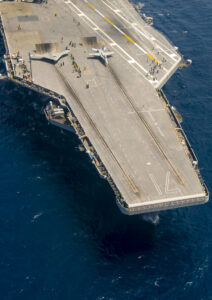[UPDATED: Key test goal met] Robots may be the future of war, but for now they’re going to have to share the battlefield with humans and human-operated vehicles. That’s especially tricky in the tight confines of a Navy carrier’s flight deck, where one miscalculation could drive a drone into a manned aircraft, the bridge island, a sailor, or the sea. Last summer, the X-47B UCAS (Unmanned Combat Air System) became the first pilotless aircraft to take off and land from a carrier — but the Navy cleared everything else off the flight deck first. Today, though, for the first time in history, the X-47B both took off and landed alongside a manned aircraft, the Navy’s standard F/A-18E Super Hornet fighter.

The X-47 drone and a manned F/A-18 Super Hornet side by side on the USS Theodore Roosevelt during the August 17 test.
In fact, the goal for today’s flight test on the USS Theodore Roosevelt was for the two aircraft to take off within 90 seconds of one another. Likewise, they both had to land within a minute and a half. (I’m still awaiting word on whether they achieved these goals). [UPDATED: The UCAS met the 90-second goal for landing and clearing the landing area, the more challenging of the two goals; the Navy’s still analyzing data on the takeoffs]. On takeoff, that means having the second aircraft so close behind the first that it must shelter behind enormous metal shields called “jet blast deflectors,” when then drop so it can taxi forward onto the catapult. On landing, it means the first aircraft must unhook itself from the arrestor cables and taxi out of the way as fast as possible. That’s tough, but it’s the kind of tempo required to hurl a fighter squadron into the air for a strike and bring them back aboard quickly when they’re running low of fuel. If drones slow things down, they can’t be used alongside manned aircraft in any kind of urgent situation.
 The whole point is to integrate unmanned aircraft seamlessly into the regular rhythm of the existing air wing. So the manned F-18 used for today’s test had “no special equipment, no upgrades,” said Capt. Beau Duarte, the Naval Air Systems Command (NAVAIR) program manager for unmanned carrier aviation, in a call with reporters Friday. It did have a professional test pilot at the controls instead of a regular Navy flier, however, for obvious safety reasons.
The whole point is to integrate unmanned aircraft seamlessly into the regular rhythm of the existing air wing. So the manned F-18 used for today’s test had “no special equipment, no upgrades,” said Capt. Beau Duarte, the Naval Air Systems Command (NAVAIR) program manager for unmanned carrier aviation, in a call with reporters Friday. It did have a professional test pilot at the controls instead of a regular Navy flier, however, for obvious safety reasons.
The Northrop-built UCAS did get upgraded for the occasion, with new software and mechanisms that allow it to detach its tailhook from the arrestor wire, fold its wings, and trundle swiftly out of the way of the next plane to land. But the demonstrator aircraft still does not have JPALS, the in-development Joint Precision Approach and Landing System being developed to guide both manned and unmanned aircraft in the future. That means not all of today’s lessons-learned will transfer to the Navy’s first operational carrier drone, Unmanned Carrier-Launched Airborne Surveillance and Strike system (UCLASS), whose design is becoming increasingly controversial on Capitol Hill.
Updated 3:30 pm Monday.

Navy jet trainer fleet operations remain paused after engine mishap
One week after the incident, a Navy spokesperson says the service is continuing to assess the fleet’s ability to safely resume flight.



























